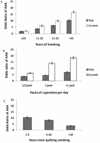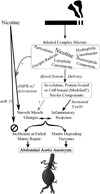Understanding the effects of tobacco smoke on the pathogenesis of aortic aneurysm
- PMID: 23685557
- PMCID: PMC3683352
- DOI: 10.1161/ATVBAHA.112.300158
Understanding the effects of tobacco smoke on the pathogenesis of aortic aneurysm
Abstract
Aneurysmal arterial disease is a vascular degenerative condition that is distinct from atherosclerotic and other occlusive arterial diseases. There is regionalization of the predisposition to aneurysm formation within the vascular tree, and the pathological process varies with location. Infrarenal abdominal aortic aneurysm (AAA) is the most common manifestation of aneurysmal disease, and smoking is the dominant risk factor. Smoking is a much greater risk factor for AAA than for atherosclerosis. In addition to playing a role in the pathogenesis of AAA, smoking also increases the rate of expansion and risk of rupture of established AAA. The mechanistic relationship between AAA and smoking is being established by the use of enhanced animal models that are dependent on smoke or smoke components. The mechanisms seem to involve durable alterations in vascular smooth muscle cell and inflammatory cell function. This review examines the clinical, epidemiological, and mechanistic evidence implicating smoking as a cause of aneurysms, focusing on AAA.
Keywords: aneurysm; pathogenesis; risk factor; smoking.
Figures


Similar articles
-
INVESTIGATING THE EFFECT OF NICOTINE FROM CIGARETTES ON THE GROWTH OF ABDOMINAL AORTIC ANEURYSMS: REVIEW.Georgian Med News. 2023 Dec;(345):183-188. Georgian Med News. 2023. PMID: 38325321 Review.
-
Lifetime Risk and Risk Factors for Abdominal Aortic Aneurysm in a 24-Year Prospective Study: The ARIC Study (Atherosclerosis Risk in Communities).Arterioscler Thromb Vasc Biol. 2016 Dec;36(12):2468-2477. doi: 10.1161/ATVBAHA.116.308147. Epub 2016 Nov 10. Arterioscler Thromb Vasc Biol. 2016. PMID: 27834688 Free PMC article.
-
Circulating cadmium concentration and risk of aortic aneurysms: A nested case-control study within the Malmö Diet and Cancer cohort.Atherosclerosis. 2017 Jun;261:37-43. doi: 10.1016/j.atherosclerosis.2017.04.007. Epub 2017 Apr 8. Atherosclerosis. 2017. PMID: 28445810
-
[Aortic disease in women].Presse Med. 2010 Feb;39(2):249-53. doi: 10.1016/j.lpm.2009.04.014. Epub 2009 Dec 16. Presse Med. 2010. PMID: 20015611 French.
-
Ruptured abdominal aortic aneurysm-epidemiology, predisposing factors, and biology.Langenbecks Arch Surg. 2016 May;401(3):275-88. doi: 10.1007/s00423-016-1401-8. Epub 2016 Mar 21. Langenbecks Arch Surg. 2016. PMID: 27001684 Review.
Cited by
-
AAA Revisited: A Comprehensive Review of Risk Factors, Management, and Hallmarks of Pathogenesis.Biomedicines. 2022 Jan 2;10(1):94. doi: 10.3390/biomedicines10010094. Biomedicines. 2022. PMID: 35052774 Free PMC article. Review.
-
Autoimmunity in the Abdominal Aortic Aneurysm and its Association with Smoking.Aorta (Stamford). 2017 Dec 1;5(6):159-167. doi: 10.12945/j.aorta.2017.17.693. eCollection 2017 Dec. Aorta (Stamford). 2017. PMID: 29766007 Free PMC article.
-
Understanding the pathogenesis of abdominal aortic aneurysms.Expert Rev Cardiovasc Ther. 2015;13(9):975-87. doi: 10.1586/14779072.2015.1074861. Expert Rev Cardiovasc Ther. 2015. PMID: 26308600 Free PMC article. Review.
-
Risk Factors for Mortality From Aortic Aneurysm and Dissection: Results From a 26-Year Follow-Up of a Community-Based Population.J Am Heart Assoc. 2023 Apr 18;12(8):e027045. doi: 10.1161/JAHA.122.027045. Epub 2023 Apr 12. J Am Heart Assoc. 2023. PMID: 37042285 Free PMC article.
-
Aortic Remodeling in Patients with Arterial Hypertension: Pathophysiological Mechanisms, Therapeutic Interventions and Preventive Strategies-A Position Paper from the Heart and Hypertension Working Group of the Italian Society of Hypertension.High Blood Press Cardiovasc Prev. 2025 May;32(3):255-273. doi: 10.1007/s40292-025-00710-3. Epub 2025 Mar 14. High Blood Press Cardiovasc Prev. 2025. PMID: 40082374 Free PMC article. Review.
References
-
- Norman PE, Powell JT. Site specificity of aneurysmal disease. Circulation. 2010;121:560–568. - PubMed
-
- Lederle FA, Johnson GR, Wilson SE, Chute EP, Hye RJ, Makaroun MS, Barone GW, Bradyk D. The aneurysm detection and management study screening program. Validation cohort and final results. Arch Int Med. 2000;160:1425–1430. - PubMed
-
- Jamrozik K, Norman PE, Spencer CA, Parsons RW, Tuohy R, Lawrence- Brown MM, Dickinson JA. Screening for abdominal aortic aneurysms: lessons from a population-based study. Med J Aust. 2000;173:345–350. - PubMed
-
- Svensjo S, Bjorck M, Gurtelschmid M, Gidlund KD, Hellberg A, Wanhainen A. Low prevalence of abdominal aortic aneurysm among 65-year-old Swedish men indicates a change in the epidemiology of the disease. Circulation. 2011;124:1118–1123. - PubMed
-
- Kent KC, Zwolak RM, Egorova NN, Riles TS, Manganaro A, Moskowitz AJ, Gelijns AC, Greco G. Analysis of risk factors for abdominal aortic aneurysm in a cohort of more than 3 million individuals. J Vasc Surg. 2010;52:539–548. - PubMed
Publication types
MeSH terms
Substances
Grants and funding
LinkOut - more resources
Full Text Sources
Other Literature Sources

